

Effect of physical inactivity on major non-communicable diseases worldwide: an analysis of burden of disease and life expectancy. Sedentary Lifestyle (Sitting Disease): How to Get Active. Too much time sitting down may spell bad news for your health.
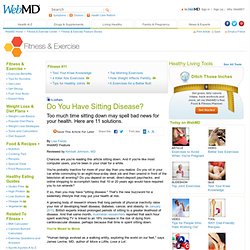
Here are 11 solutions. Why do I need to register or sign in for WebMD to save? We will provide you with a dropdown of all your saved articles when you are registered and signed in. Chances are you're reading this article sitting down. And if you're like most computer users, you've been in your chair for a while. You're probably inactive for more of your day than you realize. Do you have 'sitting disease'? Nutrition-wise blog How many hours each day do you sit?
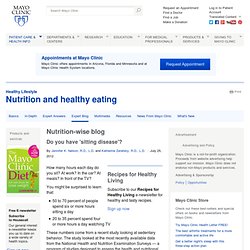
At work? In the car? JustStandInfoGraphicV3. Ergonomics Research and News. Learn about Sitting Disease. The Facts About Sitting and Standing. Occupational Sitting and Health Risks. Sitting and Health American Journal of Preventive Medicine. Occupational Sitting and Health Risks: A Systematic Review. Invited Commentary: Comparing Physical Activity Across Countries—Current Strengths and Weaknesses.
Physical activity is thought to be important for various health outcomes, but population levels are suspected to be low.
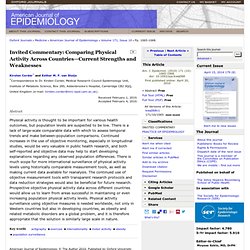
There is a lack of large-scale comparable data with which to assess temporal trends and make between-population comparisons. Continued increases in the use of objective monitoring, especially in longitudinal studies, would be very valuable in public health research, and both self-reported and objective data may help to start developing explanations regarding any observed population differences. There is much scope for more international surveillance of physical activity levels using historically comparable measurement tools, as well as making current data available for reanalysis.
The continued use of objective measurement tools with transparent research protocols and data reduction strategies would also be beneficial for future research. American Journal of Epidemiology © The Author 2010. Sedentary time and cardio-metabolic biomarkers in US adults: NHANES 2003–06. Relationship between sedentary behaviour, physical activity, muscle quality and body composition in healthy older adults. + Author Affiliations ↵*To whom correspondence should be addressed Tel: (+44) 1413313744.
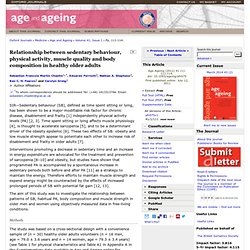
Email: sebastien.chastin@gcal.ac.uk SIR—Sedentary behaviour (SB), defined as time spent sitting or lying, has been shown to be a major modifiable risk factor for chronic disease, disablement and frailty [1] independently physical activity levels (PA) [2, 3]. Time spent sitting or lying affects muscle physiology [4], is thought to accelerate sarcopenia [5], and to be a determinant driver of the obesity epidemic [6]. Long-Term Sedentary Work and the Risk of Subsite-specific Colorectal Cancer. *↵Correspondence to Terry Boyle, Western Australian Institute for Medical Research, University of Western Australia, B Block, Queen Elizabeth II Medical Centre, Hospital Avenue, Nedlands, Western Australia 6009, Australia (e-mail: tboyle@waimr.uwa.edu.au).
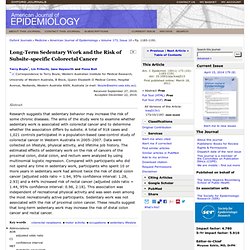
Received September 27, 2010. Accepted December 22, 2010. Research suggests that sedentary behavior may increase the risk of some chronic diseases. The aims of the study were to examine whether sedentary work is associated with colorectal cancer and to determine whether the association differs by subsite. A total of 918 cases and 1,021 controls participated in a population-based case-control study of colorectal cancer in Western Australia in 2005–2007. Abbreviations AOR adjusted odds ratio CI confidence interval MET metabolic equivalent American Journal of Epidemiology © The Author 2011. Television viewing time independently predicts all-cause and cardiovascular mortality: the EPIC Norfolk Study. Sedentary Activity Associated With Metabolic Syndrome Independent of Physical Activity. + Author Affiliations Corresponding author: Annemarie Koster, kostera@mail.nih.gov.
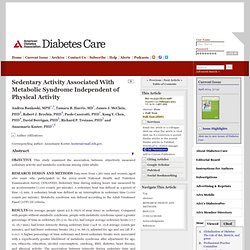
Abstract OBJECTIVE This study examined the association between objectively measured sedentary activity and metabolic syndrome among older adults. RESEARCH DESIGN AND METHODS Data were from 1,367 men and women, aged ≥60 years who participated in the 2003–2006 National Health and Nutrition Examination Survey (NHANES). Sedentary time during waking hours was measured by an accelerometer (<100 counts per minute). RESULTS On average, people spent 9.5 h (65% of wear time) as sedentary. Occupational sitting and health risks: a syste... [Am J Prev Med. 2010. Reducing Sedentary Behavior.
A New Paradigm in Physical Activity Promotion Simon J.
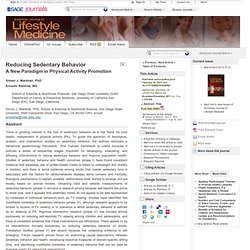
Marshall, PhD, School of Exercise & Nutritional Science, San Diego State University, 5500 Campanile Drive, San Diego, CA 92182-7251; e-mail: smarshal@mail.sdsu.edu Abstract. Preventing Chronic Disease: Volume 9, 2012: 11_0109. Are we facing a new paradigm of inactivity physiology? + Author Affiliations Correspondence to Elin Ekblom-Bak, Åstrand Laboratory of Work Physiology, Swedish School of Sport and Health Sciences, Box 5626, 114 86 Stockholm, Sweden; eline@gih.se Accepted 4 November 2009 Published Online First 4 February 2010 Evidence for the benefits of regular physical activity for several major health diseases is clear and unanimous.
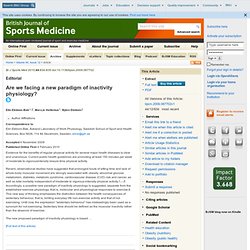
Current public health guidelines are promoting at least 150 minutes per week of moderate to vigorousintensity leisure-time physical activity. A tool for measuring workers' sitting time by domain: the Workforce Sitting Questionnaire. Too much sitting: a novel and important predictor of chronic disease risk? + Author Affiliations Neville Owen, Cancer Prevention Research Centre, School of Population Health, The University of Queensland, Herston Road, Herston 4006, Brisbane, Australia; n.owen@sph.uq.edu.au Accepted 24 October 2008 Published Online First 2 December 2008 Research on physical activity and health has pointed clearly to increasing the time that adults spend doing moderate to vigorous intensity activities: 30 minutes a day is generally recommended.

Routine Active and Sedentary Behaviour - US Adults. Stats Can - report. InfoSheet-Teen - CND.